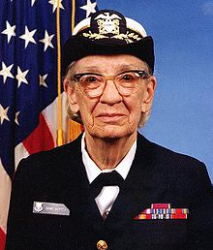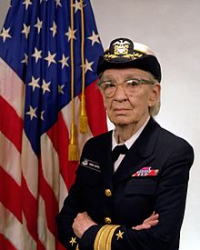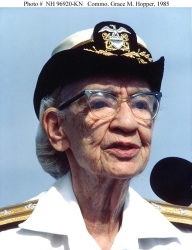
 |
|
|
||
|
Grace Brewster Hopper 'Amazing Grace' |
||||
|
Engagements: • World War II (1941 - 1945)• Korean War (1950 - 1953)• Vietnam War (1960 - 1973) |
||||
| Biography: | ||||
|
Grace Brewster Murray Hopper Grace Brewster Murray was born on 9 December 1906 in New York City, NY, the oldest in a family of three children. She was a curious child (a lifelong trait) and at the age of seven she decided to determine how an alarm clock worked. Grace had dismantled seven alarm clocks before her mother realized what she was doing and limited her to one clock. Education For her preparatory school education, she attended the Hartridge School in Plainfield, NJ. At age 16, Grace was rejected for early admission to Vassar College (her test scores in Latin were too low), but she was admitted the following year. She graduated Phi Beta Kappa from Vassar in 1928 with a Bachelor of Arts degree in Mathematics and Physics and earned her Master of Arts degree at Yale University in 1930. In 1934, she earned a Ph.D. in Mathematics from Yale under the direction of Øystein Ore. Her dissertation, New Types of Irreducibility Criteria, was published that same year. Murray began teaching Mathematics at Vassar in 1931, and was promoted to Associate Professor in 1941. From 1930 until their divorce in 1945, she was married to New York University Professor Vincent Foster Hopper (1906–1976). She never remarried and kept his surname. Military Service In 1943, during World War II, Hopper obtained a leave of absence from Vassar and was sworn into the U.S. Navy Reserve, one of many women to volunteer to serve in the WAVES (acronym for "Women Accepted for Volunteer Emergency Service"). She had to get an exemption to enlist because she was 15 pounds below the Navy minimum weight of 120 pounds. She reported in December 1943 and trained at the Naval Reserve Midshipmen's School at Smith College in Northampton, MA. Hopper graduated first in her class in 1944, and was assigned to the Bureau of Ships Computation Project at Harvard University as a Lieutenant (junior grade). She served on the Mark I computer programming staff headed by Howard H. Aiken. Hopper and Aiken coauthored three papers on the Mark I, also known as the Automatic Sequence Controlled Calculator. Grace Hopper's request to transfer to the regular Navy at the end of the war was declined due to her age (38), so she continued to serve in the Navy Reserve. Hopper remained at the Harvard Computation Lab until 1949, turning down a full professorship at Vassar in favor of working as a Research Fellow under a Navy contract at Harvard. In 1947, she was working on a Mark II computer at Harvard University when a moth was discovered in a relay, impeding the computer's operation. She is widely credited with coining the term "debugging" because of that event. Hopper pioneered the implementation of computer coding standards for testing computer systems and components. Hopper became an employee of the Eckert-Mauchly Computer Corporation as a senior mathematician in 1949 and joined the team developing the UNIVAC I. In the early 1950s, the company was taken over by the Remington Rand Corporation and it was while she was working for them that her original compiler work was done. The compiler was known as the A compiler and its first version was A-0. In 1952 she had an operational compiler. "Nobody believed that," she said. "I had a running compiler and nobody would touch it. They told me computers could only do arithmetic." Grace Hopper was named the company's first Director of Automatic Programming in 1954 and her department released some of the first compiler-based programming languages, including ARITH-MATIC, MATH-MATIC and FLOW-MATIC. In the spring of 1959, a two-day conference known as the Conference on Data Systems Languages (CODASYL) brought together computer experts from industry and government. Hopper served as the technical consultant to the committee, and many of her former employees served on the short-term committee that defined the new language, COBOL. The new language extended Hopper's FLOW-MATIC language with some ideas from the IBM equivalent, COMTRAN. Hopper's belief that programs should be written in a language that was close to English rather than in machine code or languages close to machine code (such as assembly language) was captured in the new business language, and COBOL would go on to be the most ubiquitous business language to date. From 1967 to 1977, Hopper served as Director of the Navy Programming Languages Group in the Navy's Office of Information Systems Planning and was promoted to the rank of Captain in 1973. She developed validation software for COBOL and its compiler as part of a COBOL standardization program for the entire Navy. By this time, Grace Hopper had earned two nicknames: "Amazing Grace" and "Mother of COBOL." Later in her life, she received the nickname "Grandma COBOL." In the 1970s, Hopper advocated for the Defense Department to replace large, centralized systems with networks of small, distributed computers. Any user on any computer node could access common databases located on the network. She pioneered the implementation of standards for testing computer systems and components, most significantly for early programming languages such as FORTRAN and COBOL. The Navy tests for conformance to these standards led to significant convergence among the programming language dialects of the major computer vendors. In the 1980s, these tests (and their official administration) were assumed by the National Bureau of Standards (NBS), known today as the National Institute of Standards and Technology (NIST). Retirements From the Navy Hopper retired from the Naval Reserve at age 60, in accordance with Navy attrition regulations, with the rank of Commander at the end of 1966. She was recalled to active duty in August 1967 for a six-month period that turned into an indefinite assignment. She again retired in 1971, but was asked to return to active duty in 1972. She was promoted to Captain in 1973 by Admiral Elmo R. Zumwalt, Jr. After U.S. Representative Philip Crane saw her on a March 1983 segment of 60 Minutes, he championed H.J. Res. 341, a joint resolution in the House of Representatives which led to her promotion to Commodore by special Presidential appointment. She remained on active duty for several years beyond mandatory retirement by special approval of Congress. In 1985, the rank of Commodore was renamed Rear Admiral (lower half).For the final time, RDML Grace Brewster Hopper retired (involuntarily) from the U.S. Navy on 14 August 1986. At a celebration held in Boston on the USS Constitution to celebrate her retirement, Hopper was awarded the Defense Distinguished Service Medal, the highest non-combat award possible by the Department of Defense. At the time of her retirement, she was the oldest active-duty commissioned officer in the U.S. Navy (79 years, eight months and five days), and aboard the oldest commissioned ship in the U.S. Navy (188 years, nine months and 23 days). Medals and Awards Defense Distinguished Service Medal Honors 1969: Hopper was awarded the inaugural "computer sciences man of the year" award from the Data Processing Management Association. The Fleet Numerical Meteorology and Oceanography Center is located at 7 Grace Hopper Avenue in Monterey, CA. Grace Murray Hopper Park, located on South Joyce Street in Arlington, VA, is a small memorial park in front of her former residence (River House Apartments) and is now owned by Arlington County, VA. Women at the world's largest software company, Microsoft Corporation, formed an employee group called Hoppers and established a scholarship in her honor. Hoppers has over 3000 members worldwide. Brewster Academy, a school located in Wolfeboro, NH, dedicated their computer lab to her in 1985, calling it the Grace Murray Hopper Center for Computer Learning. The academy bestows a Grace Murray Hopper Prize to a graduate who excelled in the field of computer systems. Hopper had spent her childhood summers at a family home in Wolfeboro. An administration building on Naval Support Activity Annapolis (previously known as Naval Station Annapolis) in Annapolis, MD, is named the Grace Hopper Building in her honor. Building 1482 aboard Naval Air Station North Island, housing the Naval Computer and Telecommunication Station San Diego, is named the Grace Hopper Building. Building 6007, C2/CNT West, Command, control, communications, computers, intelligence, surveillance and reconnaissance, or C4ISR, Center of Excellence in Aberdeen Proving Ground, MD, is named the Rear Admiral Grace Hopper Building. A named professorship in the Department of Computer Sciences was established at Yale University in her honor. Joan Fiegenbaum was named to this chair in 2008. Grace Hopper's legacy was an inspiring factor in the creation of the Grace Hopper Celebration of Women in Computing. Held yearly, this conference is designed to bring the research and career interests of women in computing to the forefront. A bridge over Goose Creek joining the north and south sides of the Naval Support Activity Charleston side of Joint Base Charleston, SC, is named the Grace Hopper Memorial Bridge in her honor. Grace Hopper was awarded 40 honorary degrees from universities worldwide during her lifetime. Death and Burial RDML Grace Brewster Murray Hopper died on 1 January 1992. She is buried at Arlington National Cemetery in Arlington, VA. |
||||
| Honoree ID: 2649 | Created by: MHOH | |||
Ribbons
Medals
Badges
Honoree Photos
 |  |  |
 |  |
 |


